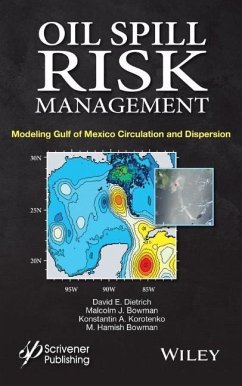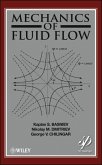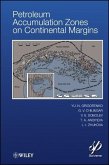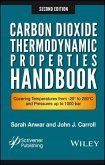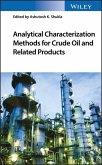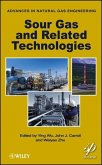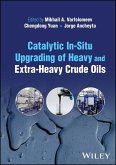David E Dietrich, Malcolm J Bowman, Konstantin A Korotenko, M Hamish E BowmanModeling Gulf of Mexico Circulation and Oil Dispersal
Oil Spill Risk Management
Modeling Gulf of Mexico Circulation and Oil Dispersal
By Dietrich, David E.; Bowman, Malcolm J.; Korotenko, Konstantin A.; Bowman, M. Hamish E.
David E Dietrich, Malcolm J Bowman, Konstantin A Korotenko, M Hamish E BowmanModeling Gulf of Mexico Circulation and Oil Dispersal
Oil Spill Risk Management
Modeling Gulf of Mexico Circulation and Oil Dispersal
By Dietrich, David E.; Bowman, Malcolm J.; Korotenko, Konstantin A.; Bowman, M. Hamish E.
- Gebundenes Buch
- Merkliste
- Auf die Merkliste
- Bewerten Bewerten
- Teilen
- Produkt teilen
- Produkterinnerung
- Produkterinnerung
This book is designed to help scientifically astute non-specialists understand basic geophysical and computational fluid dynamics concepts relating to oil spill simulations, and related modeling issues and challenges. A valuable asset to the engineer or manager working off-shore in the oil and gas industry, the authors, a team of renowned geologists and engineers, offer practical applications to mitigate any offshore spill risks, using research never before published.
Andere Kunden interessierten sich auch für
![Mechanics of Fluid Flow Mechanics of Fluid Flow]() Kaplan S. BasnievMechanics of Fluid Flow222,99 €
Kaplan S. BasnievMechanics of Fluid Flow222,99 €![Petroleum Accumulation Zones on Continental Margins Petroleum Accumulation Zones on Continental Margins]() V. S. SobolevPetroleum Accumulation Zones on Continental Margins222,99 €
V. S. SobolevPetroleum Accumulation Zones on Continental Margins222,99 €![Carbon Dioxide Thermodynamic Properties Handbook Carbon Dioxide Thermodynamic Properties Handbook]() Sara AnwarCarbon Dioxide Thermodynamic Properties Handbook316,99 €
Sara AnwarCarbon Dioxide Thermodynamic Properties Handbook316,99 €![Analytical Characterization Methods for Crude Oil and Related Products Analytical Characterization Methods for Crude Oil and Related Products]() Analytical Characterization Methods for Crude Oil and Related Products166,99 €
Analytical Characterization Methods for Crude Oil and Related Products166,99 €![Sour Gas and Related Technologies Sour Gas and Related Technologies]() John J. CarrollSour Gas and Related Technologies228,99 €
John J. CarrollSour Gas and Related Technologies228,99 €![Petrochemistry Petrochemistry]() Martin BajusPetrochemistry78,99 €
Martin BajusPetrochemistry78,99 €![Catalytic In-Situ Upgrading of Heavy and Extra-Heavy Crude Oils Catalytic In-Situ Upgrading of Heavy and Extra-Heavy Crude Oils]() Catalytic In-Situ Upgrading of Heavy and Extra-Heavy Crude Oils222,99 €
Catalytic In-Situ Upgrading of Heavy and Extra-Heavy Crude Oils222,99 €-
-
-
This book is designed to help scientifically astute non-specialists understand basic geophysical and computational fluid dynamics concepts relating to oil spill simulations, and related modeling issues and challenges. A valuable asset to the engineer or manager working off-shore in the oil and gas industry, the authors, a team of renowned geologists and engineers, offer practical applications to mitigate any offshore spill risks, using research never before published.
Hinweis: Dieser Artikel kann nur an eine deutsche Lieferadresse ausgeliefert werden.
Hinweis: Dieser Artikel kann nur an eine deutsche Lieferadresse ausgeliefert werden.
Produktdetails
- Produktdetails
- Verlag: Wiley & Sons
- 1. Auflage
- Seitenzahl: 240
- Erscheinungstermin: November 2014
- Englisch
- Abmessung: 236mm x 157mm x 18mm
- Gewicht: 544g
- ISBN-13: 9781118290385
- ISBN-10: 1118290380
- Artikelnr.: 36898913
- Herstellerkennzeichnung
- Libri GmbH
- Europaallee 1
- 36244 Bad Hersfeld
- gpsr@libri.de
- Verlag: Wiley & Sons
- 1. Auflage
- Seitenzahl: 240
- Erscheinungstermin: November 2014
- Englisch
- Abmessung: 236mm x 157mm x 18mm
- Gewicht: 544g
- ISBN-13: 9781118290385
- ISBN-10: 1118290380
- Artikelnr.: 36898913
- Herstellerkennzeichnung
- Libri GmbH
- Europaallee 1
- 36244 Bad Hersfeld
- gpsr@libri.de
David Dietrich, PhD, is a leading scientist in geophysical fluid dynamics and has over 50 publications in modeling ocean and engineering flows, including applications of his internationally used DieCAST ocean flow model. He has done work all over the world, including a number of projects with the US Navy. Malcolm Bowman is Professor of Physical Oceanography and Distinguished Service Professor at Stony Brook University's School of Marine and Atmospheric Sciences. He is the Founding Director of the Stony Brook Storm Surge Research Group, President of the Stony Brook Environmental Conservancy, a Distinguished Member of the National Society of Collegiate Scholars and a Director of the Environmental Defence Society (NZ). He served on NY Mayor Bloomberg's Panel on Climate Change, which advises the City on how best to protect the city against the threats of climate change and rising sea levels. Konstantin A. Korotenko is a Research Professor of Physical Oceanography at the P.P. Shirshov Institute of Oceanology of the Russian Academy of Sciences. He researches ocean dynamics and turbulence and pollution transport in the ocean. His works published in international journals are devoted to circulation and environmental problems of the Adriatic, Baltic, Black, Caspian seas and the Gulf of Mexico. He is an executive board member of the Moscow Physical Society, American Geophysical Union and an expert of the Fulbright Scholarship Program. Hamish Bowman is a research scientist at the University of Otago in Dunedin, New Zealand, where he runs the Geophysics Research Laboratory and curates its computational computing cluster. He is a core member of the GRASS GIS Development Team, specializing in cartographic programming and the efficient processing of large data arrays.
Preface xiii
Part 1: Applied Oil Spill Modeling (with applications to the Deepwater
Horizon oil spill) 1
1 The 2010 Deep Water Horizon and 2002 Supertanker Prestige Accidents 3
1.1 Introduction 3
1.2 The Oil Spills Described 5
1.3 How Much Material Remains in the Gulf? 6
1.4 The Role of Ocean Models to Explain what Happened 7
References 8
2 Gulf of Mexico Circulation 9
2.1 General Characteristics 9
2.2 Exchanges at Lateral and Surface Boundaries 11
2.3 Loop Current Eddies 12
2.4 Blocking by the Pycnocline 13
2.5 Fate of the Deepwater Horizon Well Blowout Material 14
2.6 Summary 15
References 16
3 Geophysical Fluid Dynamics and Modeling Challenges 17
3.1 Modeling the Circulation and Mixing of the Gulf Waters 17
3.2 External Boundaries 18
3.3 Addressing the Water Column Contamination and Fluxes 18
3.4 Eff ects of Bottom Dynamics on Accumulated Hydrocarbons 20
3.5 Churning by Extreme Weather Events 20
3.6 Summary 21
References 22
4 Flow and Oil Transport Model Choices, Setup and Testing 23
4.1 The DieCAST Ocean Circulation Model 23
4.2 Korotenko Oil Transport Module KOTM 24
4.3 Gulf Modeling Approach 25
4.4 Model Vertical Eddy Viscosity and Diff usivity 25
4.5 Surface Wind Driving and Open Boundary Conditions 26
4.6 Comments on Modeling Equatorial Dynamics and the Gulf of Mexico 26
4.7 Modeling Multi-Century Gulf Currents 27
References 29
5 Modeling the 2010 DWH Oil Spill 31
5.1 Introduction: the BP/Deepwater Horizon Accident 31
5.2 Deepwater Blowouts: Processes Affecting the Transport and Fate of Oil
throughout the Water Column 32
5.3 Oil Spill Model for Gulf of Mexico (GOSM) 57
5.4 Results and Discussion 68
5.5 Summary 82
References 86
Part 2: Special Topics in Oil Spill Modeling 95
6 DieCAST Model Origin and Development 97
6.1 Introduction 97
6.2 Recent Model Attributes 98
6.3 Challenges in Modeling the Gulf of Mexico Circulation 99
6.4 Complications of Modeling near-Equatorial Circulation 99
6.5 Non Hydrostatic Effects 101
6.6 Sponge Layers in the Global Model 101
6.7 Inflow Considerations 101
References 102
7 Brief History of the Community Ocean Modeling System (COMS) 105
7.1 COMS history 105
7.2 Background and motivations 106
7.3 COMS elliptic solver history 107
7.4 Evolution of DieCAST 108
7.5 Outlook 108
References 110
8 DieCAST Model Equations 113
8.1 Model Equations 113
8.2 Model Layer Depths 115
References 116
9 Some Basic Physical, Mathematical and Modeling Concepts 117
9.1 Buoyancy, Density and the Hydrostatic Approximation 117
9.2 Pycnocline Slope: Geopotential Surface as a Natural Vertical Coordinate
119
9.3 Rotation and Coriolis Terms 120
9.4 Pycnocline and the Florida Strait Sill Depth 121
9.5 Surface and Bottom Mixed Layers 121
References 122
10 Modeling Challenges, Validations and Animations 125
10.1 Incompressibility, Geostrophy, Data Assimilation and Initialization
Issues 125
10.2 Thermocline Maintenance, Ventilation and Extreme Events 127
10.3 Nesting, Grid Coupling and Open Boundary Conditions 127
10.4 Validation of Simulated Major Current Patterns in the Gulf 127
10.5 Note on Data Assimilation 133
10.6 Gulf Circulation Animations 134
10.7 Animation 1 134
10.8 Animation 2 135
10.9 Animation 3 136
References 136
11 A Five-Century Gulf Simulation using DieCAST 139
11.1 Motivation 139
11.2 Basic Flow Patterns 140
11.3 Some Results Observed during the 5th Century 142
11.4 Internal Waves 143
11.5 Island /Headland Wake Eff ects in the Yucatan Channel 143
11.6 Deeply Suspended and Bottom Deposited Material 144
References 145
12 Extreme Events and Oil Rig Stability 147
12.1 Introduction 147
12.2 An Unusual Northern Gulf Eddy Event 148
12.3 Detailed Discussion of Run A 148
12.4 Some Comments 151
12.5 Other Extreme Events Found during the 500-year simulation 152
References 153
13 Initialization and Data Assimilation; MAM Procedure 155
13.1 Introduction 155
13.2 Preliminary Comment 156
13.3 MAM Procedure 156
13.4 Refinements, Variations, Generalizations and Specializations of the
MAM Approach 158
References 160
14 On the Simulation of Density Currents by z-level Models 161
14.1 Motivation 161
14.2 Introduction 162
14.3 Analysis 164
14.4 Summary and Conclusion 167
14.5 Acknowledgements 168
References 168
Appendix I: Notes on Modeling Hurricanes with DieCAST 171
A1.1 Introduction 171
A1.2 Model Setup 172
A1.3 Results and Discussion 174
A1.4 Final Remarks 178
A1.5 Summary 179
A1.6 Acknowledgements 179
References 179
Appendix II: A Model Study of Ventilation of the Mississippi Bight by
Baroclinic Eddies: Local Instability and Remote Loop Current Effects 181
A2.1 Abstract 181
A2.2 Introduction 182
A2.3 Model Setup 183
A2.4 Results 184
A2.5 Concluding Remarks 208
References 213
Index 215
Part 1: Applied Oil Spill Modeling (with applications to the Deepwater
Horizon oil spill) 1
1 The 2010 Deep Water Horizon and 2002 Supertanker Prestige Accidents 3
1.1 Introduction 3
1.2 The Oil Spills Described 5
1.3 How Much Material Remains in the Gulf? 6
1.4 The Role of Ocean Models to Explain what Happened 7
References 8
2 Gulf of Mexico Circulation 9
2.1 General Characteristics 9
2.2 Exchanges at Lateral and Surface Boundaries 11
2.3 Loop Current Eddies 12
2.4 Blocking by the Pycnocline 13
2.5 Fate of the Deepwater Horizon Well Blowout Material 14
2.6 Summary 15
References 16
3 Geophysical Fluid Dynamics and Modeling Challenges 17
3.1 Modeling the Circulation and Mixing of the Gulf Waters 17
3.2 External Boundaries 18
3.3 Addressing the Water Column Contamination and Fluxes 18
3.4 Eff ects of Bottom Dynamics on Accumulated Hydrocarbons 20
3.5 Churning by Extreme Weather Events 20
3.6 Summary 21
References 22
4 Flow and Oil Transport Model Choices, Setup and Testing 23
4.1 The DieCAST Ocean Circulation Model 23
4.2 Korotenko Oil Transport Module KOTM 24
4.3 Gulf Modeling Approach 25
4.4 Model Vertical Eddy Viscosity and Diff usivity 25
4.5 Surface Wind Driving and Open Boundary Conditions 26
4.6 Comments on Modeling Equatorial Dynamics and the Gulf of Mexico 26
4.7 Modeling Multi-Century Gulf Currents 27
References 29
5 Modeling the 2010 DWH Oil Spill 31
5.1 Introduction: the BP/Deepwater Horizon Accident 31
5.2 Deepwater Blowouts: Processes Affecting the Transport and Fate of Oil
throughout the Water Column 32
5.3 Oil Spill Model for Gulf of Mexico (GOSM) 57
5.4 Results and Discussion 68
5.5 Summary 82
References 86
Part 2: Special Topics in Oil Spill Modeling 95
6 DieCAST Model Origin and Development 97
6.1 Introduction 97
6.2 Recent Model Attributes 98
6.3 Challenges in Modeling the Gulf of Mexico Circulation 99
6.4 Complications of Modeling near-Equatorial Circulation 99
6.5 Non Hydrostatic Effects 101
6.6 Sponge Layers in the Global Model 101
6.7 Inflow Considerations 101
References 102
7 Brief History of the Community Ocean Modeling System (COMS) 105
7.1 COMS history 105
7.2 Background and motivations 106
7.3 COMS elliptic solver history 107
7.4 Evolution of DieCAST 108
7.5 Outlook 108
References 110
8 DieCAST Model Equations 113
8.1 Model Equations 113
8.2 Model Layer Depths 115
References 116
9 Some Basic Physical, Mathematical and Modeling Concepts 117
9.1 Buoyancy, Density and the Hydrostatic Approximation 117
9.2 Pycnocline Slope: Geopotential Surface as a Natural Vertical Coordinate
119
9.3 Rotation and Coriolis Terms 120
9.4 Pycnocline and the Florida Strait Sill Depth 121
9.5 Surface and Bottom Mixed Layers 121
References 122
10 Modeling Challenges, Validations and Animations 125
10.1 Incompressibility, Geostrophy, Data Assimilation and Initialization
Issues 125
10.2 Thermocline Maintenance, Ventilation and Extreme Events 127
10.3 Nesting, Grid Coupling and Open Boundary Conditions 127
10.4 Validation of Simulated Major Current Patterns in the Gulf 127
10.5 Note on Data Assimilation 133
10.6 Gulf Circulation Animations 134
10.7 Animation 1 134
10.8 Animation 2 135
10.9 Animation 3 136
References 136
11 A Five-Century Gulf Simulation using DieCAST 139
11.1 Motivation 139
11.2 Basic Flow Patterns 140
11.3 Some Results Observed during the 5th Century 142
11.4 Internal Waves 143
11.5 Island /Headland Wake Eff ects in the Yucatan Channel 143
11.6 Deeply Suspended and Bottom Deposited Material 144
References 145
12 Extreme Events and Oil Rig Stability 147
12.1 Introduction 147
12.2 An Unusual Northern Gulf Eddy Event 148
12.3 Detailed Discussion of Run A 148
12.4 Some Comments 151
12.5 Other Extreme Events Found during the 500-year simulation 152
References 153
13 Initialization and Data Assimilation; MAM Procedure 155
13.1 Introduction 155
13.2 Preliminary Comment 156
13.3 MAM Procedure 156
13.4 Refinements, Variations, Generalizations and Specializations of the
MAM Approach 158
References 160
14 On the Simulation of Density Currents by z-level Models 161
14.1 Motivation 161
14.2 Introduction 162
14.3 Analysis 164
14.4 Summary and Conclusion 167
14.5 Acknowledgements 168
References 168
Appendix I: Notes on Modeling Hurricanes with DieCAST 171
A1.1 Introduction 171
A1.2 Model Setup 172
A1.3 Results and Discussion 174
A1.4 Final Remarks 178
A1.5 Summary 179
A1.6 Acknowledgements 179
References 179
Appendix II: A Model Study of Ventilation of the Mississippi Bight by
Baroclinic Eddies: Local Instability and Remote Loop Current Effects 181
A2.1 Abstract 181
A2.2 Introduction 182
A2.3 Model Setup 183
A2.4 Results 184
A2.5 Concluding Remarks 208
References 213
Index 215
Preface xiii
Part 1: Applied Oil Spill Modeling (with applications to the Deepwater
Horizon oil spill) 1
1 The 2010 Deep Water Horizon and 2002 Supertanker Prestige Accidents 3
1.1 Introduction 3
1.2 The Oil Spills Described 5
1.3 How Much Material Remains in the Gulf? 6
1.4 The Role of Ocean Models to Explain what Happened 7
References 8
2 Gulf of Mexico Circulation 9
2.1 General Characteristics 9
2.2 Exchanges at Lateral and Surface Boundaries 11
2.3 Loop Current Eddies 12
2.4 Blocking by the Pycnocline 13
2.5 Fate of the Deepwater Horizon Well Blowout Material 14
2.6 Summary 15
References 16
3 Geophysical Fluid Dynamics and Modeling Challenges 17
3.1 Modeling the Circulation and Mixing of the Gulf Waters 17
3.2 External Boundaries 18
3.3 Addressing the Water Column Contamination and Fluxes 18
3.4 Eff ects of Bottom Dynamics on Accumulated Hydrocarbons 20
3.5 Churning by Extreme Weather Events 20
3.6 Summary 21
References 22
4 Flow and Oil Transport Model Choices, Setup and Testing 23
4.1 The DieCAST Ocean Circulation Model 23
4.2 Korotenko Oil Transport Module KOTM 24
4.3 Gulf Modeling Approach 25
4.4 Model Vertical Eddy Viscosity and Diff usivity 25
4.5 Surface Wind Driving and Open Boundary Conditions 26
4.6 Comments on Modeling Equatorial Dynamics and the Gulf of Mexico 26
4.7 Modeling Multi-Century Gulf Currents 27
References 29
5 Modeling the 2010 DWH Oil Spill 31
5.1 Introduction: the BP/Deepwater Horizon Accident 31
5.2 Deepwater Blowouts: Processes Affecting the Transport and Fate of Oil
throughout the Water Column 32
5.3 Oil Spill Model for Gulf of Mexico (GOSM) 57
5.4 Results and Discussion 68
5.5 Summary 82
References 86
Part 2: Special Topics in Oil Spill Modeling 95
6 DieCAST Model Origin and Development 97
6.1 Introduction 97
6.2 Recent Model Attributes 98
6.3 Challenges in Modeling the Gulf of Mexico Circulation 99
6.4 Complications of Modeling near-Equatorial Circulation 99
6.5 Non Hydrostatic Effects 101
6.6 Sponge Layers in the Global Model 101
6.7 Inflow Considerations 101
References 102
7 Brief History of the Community Ocean Modeling System (COMS) 105
7.1 COMS history 105
7.2 Background and motivations 106
7.3 COMS elliptic solver history 107
7.4 Evolution of DieCAST 108
7.5 Outlook 108
References 110
8 DieCAST Model Equations 113
8.1 Model Equations 113
8.2 Model Layer Depths 115
References 116
9 Some Basic Physical, Mathematical and Modeling Concepts 117
9.1 Buoyancy, Density and the Hydrostatic Approximation 117
9.2 Pycnocline Slope: Geopotential Surface as a Natural Vertical Coordinate
119
9.3 Rotation and Coriolis Terms 120
9.4 Pycnocline and the Florida Strait Sill Depth 121
9.5 Surface and Bottom Mixed Layers 121
References 122
10 Modeling Challenges, Validations and Animations 125
10.1 Incompressibility, Geostrophy, Data Assimilation and Initialization
Issues 125
10.2 Thermocline Maintenance, Ventilation and Extreme Events 127
10.3 Nesting, Grid Coupling and Open Boundary Conditions 127
10.4 Validation of Simulated Major Current Patterns in the Gulf 127
10.5 Note on Data Assimilation 133
10.6 Gulf Circulation Animations 134
10.7 Animation 1 134
10.8 Animation 2 135
10.9 Animation 3 136
References 136
11 A Five-Century Gulf Simulation using DieCAST 139
11.1 Motivation 139
11.2 Basic Flow Patterns 140
11.3 Some Results Observed during the 5th Century 142
11.4 Internal Waves 143
11.5 Island /Headland Wake Eff ects in the Yucatan Channel 143
11.6 Deeply Suspended and Bottom Deposited Material 144
References 145
12 Extreme Events and Oil Rig Stability 147
12.1 Introduction 147
12.2 An Unusual Northern Gulf Eddy Event 148
12.3 Detailed Discussion of Run A 148
12.4 Some Comments 151
12.5 Other Extreme Events Found during the 500-year simulation 152
References 153
13 Initialization and Data Assimilation; MAM Procedure 155
13.1 Introduction 155
13.2 Preliminary Comment 156
13.3 MAM Procedure 156
13.4 Refinements, Variations, Generalizations and Specializations of the
MAM Approach 158
References 160
14 On the Simulation of Density Currents by z-level Models 161
14.1 Motivation 161
14.2 Introduction 162
14.3 Analysis 164
14.4 Summary and Conclusion 167
14.5 Acknowledgements 168
References 168
Appendix I: Notes on Modeling Hurricanes with DieCAST 171
A1.1 Introduction 171
A1.2 Model Setup 172
A1.3 Results and Discussion 174
A1.4 Final Remarks 178
A1.5 Summary 179
A1.6 Acknowledgements 179
References 179
Appendix II: A Model Study of Ventilation of the Mississippi Bight by
Baroclinic Eddies: Local Instability and Remote Loop Current Effects 181
A2.1 Abstract 181
A2.2 Introduction 182
A2.3 Model Setup 183
A2.4 Results 184
A2.5 Concluding Remarks 208
References 213
Index 215
Part 1: Applied Oil Spill Modeling (with applications to the Deepwater
Horizon oil spill) 1
1 The 2010 Deep Water Horizon and 2002 Supertanker Prestige Accidents 3
1.1 Introduction 3
1.2 The Oil Spills Described 5
1.3 How Much Material Remains in the Gulf? 6
1.4 The Role of Ocean Models to Explain what Happened 7
References 8
2 Gulf of Mexico Circulation 9
2.1 General Characteristics 9
2.2 Exchanges at Lateral and Surface Boundaries 11
2.3 Loop Current Eddies 12
2.4 Blocking by the Pycnocline 13
2.5 Fate of the Deepwater Horizon Well Blowout Material 14
2.6 Summary 15
References 16
3 Geophysical Fluid Dynamics and Modeling Challenges 17
3.1 Modeling the Circulation and Mixing of the Gulf Waters 17
3.2 External Boundaries 18
3.3 Addressing the Water Column Contamination and Fluxes 18
3.4 Eff ects of Bottom Dynamics on Accumulated Hydrocarbons 20
3.5 Churning by Extreme Weather Events 20
3.6 Summary 21
References 22
4 Flow and Oil Transport Model Choices, Setup and Testing 23
4.1 The DieCAST Ocean Circulation Model 23
4.2 Korotenko Oil Transport Module KOTM 24
4.3 Gulf Modeling Approach 25
4.4 Model Vertical Eddy Viscosity and Diff usivity 25
4.5 Surface Wind Driving and Open Boundary Conditions 26
4.6 Comments on Modeling Equatorial Dynamics and the Gulf of Mexico 26
4.7 Modeling Multi-Century Gulf Currents 27
References 29
5 Modeling the 2010 DWH Oil Spill 31
5.1 Introduction: the BP/Deepwater Horizon Accident 31
5.2 Deepwater Blowouts: Processes Affecting the Transport and Fate of Oil
throughout the Water Column 32
5.3 Oil Spill Model for Gulf of Mexico (GOSM) 57
5.4 Results and Discussion 68
5.5 Summary 82
References 86
Part 2: Special Topics in Oil Spill Modeling 95
6 DieCAST Model Origin and Development 97
6.1 Introduction 97
6.2 Recent Model Attributes 98
6.3 Challenges in Modeling the Gulf of Mexico Circulation 99
6.4 Complications of Modeling near-Equatorial Circulation 99
6.5 Non Hydrostatic Effects 101
6.6 Sponge Layers in the Global Model 101
6.7 Inflow Considerations 101
References 102
7 Brief History of the Community Ocean Modeling System (COMS) 105
7.1 COMS history 105
7.2 Background and motivations 106
7.3 COMS elliptic solver history 107
7.4 Evolution of DieCAST 108
7.5 Outlook 108
References 110
8 DieCAST Model Equations 113
8.1 Model Equations 113
8.2 Model Layer Depths 115
References 116
9 Some Basic Physical, Mathematical and Modeling Concepts 117
9.1 Buoyancy, Density and the Hydrostatic Approximation 117
9.2 Pycnocline Slope: Geopotential Surface as a Natural Vertical Coordinate
119
9.3 Rotation and Coriolis Terms 120
9.4 Pycnocline and the Florida Strait Sill Depth 121
9.5 Surface and Bottom Mixed Layers 121
References 122
10 Modeling Challenges, Validations and Animations 125
10.1 Incompressibility, Geostrophy, Data Assimilation and Initialization
Issues 125
10.2 Thermocline Maintenance, Ventilation and Extreme Events 127
10.3 Nesting, Grid Coupling and Open Boundary Conditions 127
10.4 Validation of Simulated Major Current Patterns in the Gulf 127
10.5 Note on Data Assimilation 133
10.6 Gulf Circulation Animations 134
10.7 Animation 1 134
10.8 Animation 2 135
10.9 Animation 3 136
References 136
11 A Five-Century Gulf Simulation using DieCAST 139
11.1 Motivation 139
11.2 Basic Flow Patterns 140
11.3 Some Results Observed during the 5th Century 142
11.4 Internal Waves 143
11.5 Island /Headland Wake Eff ects in the Yucatan Channel 143
11.6 Deeply Suspended and Bottom Deposited Material 144
References 145
12 Extreme Events and Oil Rig Stability 147
12.1 Introduction 147
12.2 An Unusual Northern Gulf Eddy Event 148
12.3 Detailed Discussion of Run A 148
12.4 Some Comments 151
12.5 Other Extreme Events Found during the 500-year simulation 152
References 153
13 Initialization and Data Assimilation; MAM Procedure 155
13.1 Introduction 155
13.2 Preliminary Comment 156
13.3 MAM Procedure 156
13.4 Refinements, Variations, Generalizations and Specializations of the
MAM Approach 158
References 160
14 On the Simulation of Density Currents by z-level Models 161
14.1 Motivation 161
14.2 Introduction 162
14.3 Analysis 164
14.4 Summary and Conclusion 167
14.5 Acknowledgements 168
References 168
Appendix I: Notes on Modeling Hurricanes with DieCAST 171
A1.1 Introduction 171
A1.2 Model Setup 172
A1.3 Results and Discussion 174
A1.4 Final Remarks 178
A1.5 Summary 179
A1.6 Acknowledgements 179
References 179
Appendix II: A Model Study of Ventilation of the Mississippi Bight by
Baroclinic Eddies: Local Instability and Remote Loop Current Effects 181
A2.1 Abstract 181
A2.2 Introduction 182
A2.3 Model Setup 183
A2.4 Results 184
A2.5 Concluding Remarks 208
References 213
Index 215

